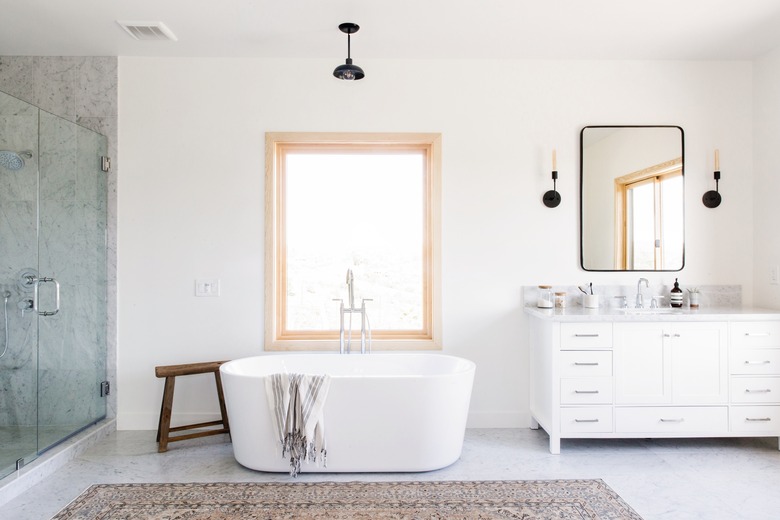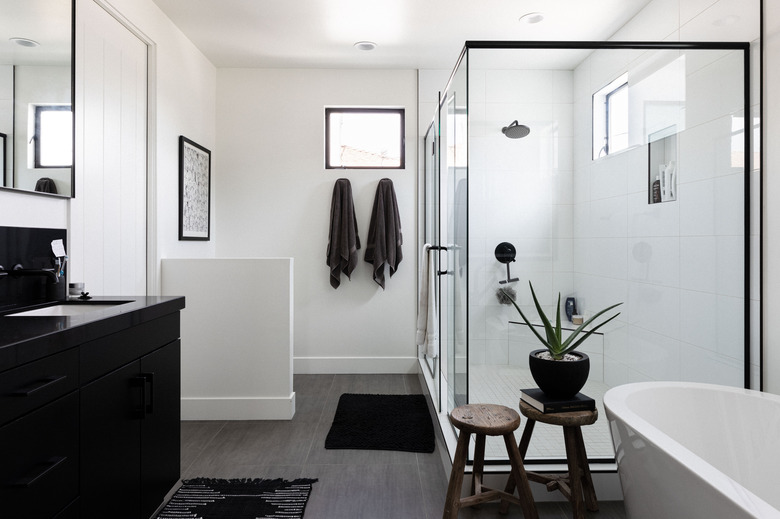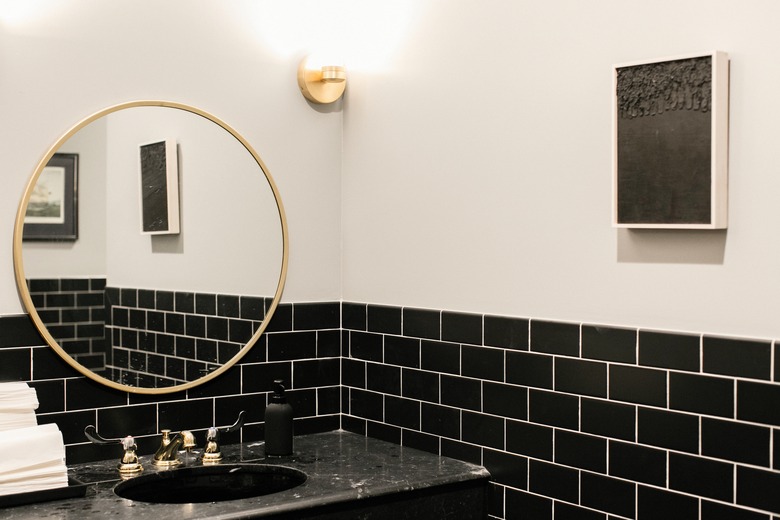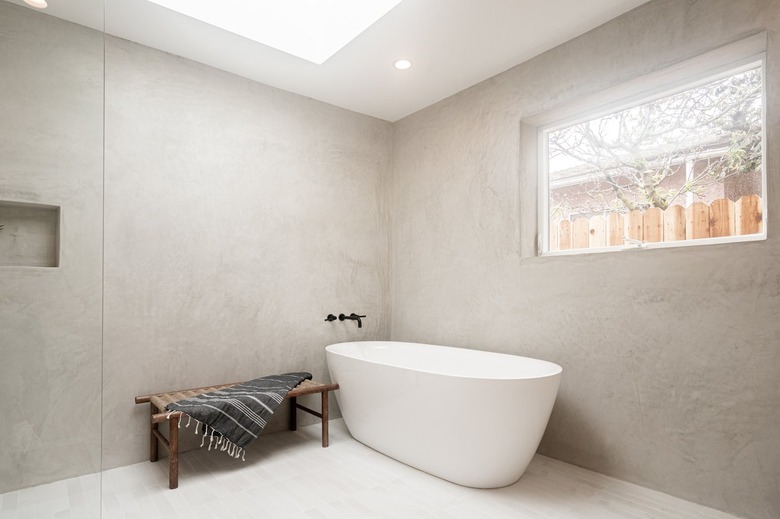How Much Does A Bathroom Remodel Cost In 2022?
Bathroom remodeling projects are popular because they provide the chance to upgrade the design of the room while making the space more functional. Bathroom remodel costs are affected by the size of the area, changes to the original layout and the quality of the new fixtures and fittings.
Tip
Typically, the average bathroom remodeling cost is between $6,000 and $15,000. The average cost per square foot is $150 to $250, but high-end fixtures and custom-made products can drive up costs quickly.
Cost for Full Bathroom Remodel
Cost for Full Bathroom Remodel
For a full renovation, the average bathroom remodel cost for a room that is 40 to 90 square feet will cost between $6,000 and $15,000. The costs include demolition of wall and floor finishes and removing and replacing all fixtures and cabinetry. These projects often include behind-the-wall plumbing and electrical work. New plumbing fixtures, cabinetry, lighting and wall and floor finishes are also part of the project.
Bathroom remodel costs can be high because they consist of potentially high-price fixtures and finishes that are added to a small space. Sometimes, the cramped quarters lead to higher labor costs. Costs are generally higher in areas with strong real estate markets because labor costs tend to be higher with up to a 20 percent difference in labor costs among different geographic areas.
The type of bathroom can also determine the cost. Master bathrooms, which usually include two sinks and a separate tub and shower, can cost $20,000 to over $50,000. Family bathrooms with one vanity and sink and a tub/shower combination can cost $6,000 to $30,000. On average, remodeling to accommodate someone with special needs by widening doorways and installing grab bars and a roll-in shower can cost $5,000 to $10,000, but costs in this category can quickly grow to $30,000 or more. Powder rooms can range from $5,000 to $20,000.
Cost for Partial Bathroom Remodel
Cost for Partial Bathroom Remodel
Not every bathroom bathroom makeover involves stripping the room down to the studs and starting from scratch. Replacing a dated vanity, sink and faucet, adding a fresh coat of paint and installing new light fixtures can vastly improve an old bathroom. You can accomplish that for between $500 and $4,000.
Replacing old plumbing fixtures with new ones can upgrade a bathroom just as new appliances improve a kitchen. Pull-and-replace projects usually involve removing the existing toilet, vanity, light fixtures and tub and shower. Replacing them can cost $3,000 to $15,000 depending on the quality of the new products.
Some companies specialize in renewing tub and shower areas. These projects include reglazing the bathtub or installing a new outer shell over the old tub as well as covering the walls around the tub and shower with new finish material. These companies offer a choice in materials and colors, and the surrounds often include built-in shelves and other accessories. Prices range from $5,000 to $8,000.
The Cost of Adding On a Bathroom
The Cost of Adding On a Bathroom
Expanding an existing bathroom or building an addition that includes a bathroom is on many homeowner wish lists. Adding a bathroom will increase the value of the house, but if you are appropriating another room or part of another room for the bathroom, the project will include demolition and construction costs as well as plumbing and electrical work. However, you will be working within a space that already exists.
A new addition comes with costs not associated with a remodeled bathroom because a room addition is similar to building a whole house in miniature. In addition to everything that goes into a bathroom, there is the cost of the foundation, exterior walls, siding and roofing as well as bathroom doors and windows. You may need to upgrade your home's heating and cooling system to accommodate the new space.
A 100-square-foot bathroom addition can cost $40,000 to $75,000 for a room with good-quality fixtures and finishes. Building a larger room to create a suite with high-end fixtures, a freestanding tub, a separate shower and two vanities with stone countertops can easily cost over $100,000.
Bathroom Remodeling Return on Investment
Bathroom Remodeling Return on Investment
Bathroom remodeling projects can cost big bucks, so many homeowners wonder what their investment will get them when they put their house on the market. To be clear, the main purpose of a bathroom remodeling project is improving the comfort and functionality of the room for you and your family. While a well-executed project will increase the value of the house, it probably won't recoup the entire investment.
Remodeling's 2020 cost vs. value report examines bathroom remodeling projects and the value they add to the house. The job costs listed tend to be higher than other estimates because Remodeling designs a project and then costs it out using estimating software. Other estimates come from a survey of completed projects. The report supplies national averages, and it lets you drill down for costs in many metro areas.
A standard bathroom with good-quality fixtures will return about 64 percent of the original cost at resale. Relatively modest projects tend to offer better returns than higher-end projects. An upscale standard bath is estimated to return 56.6 percent, and a bathroom addition might yield 54.7 percent. A project with universal design upgrades is estimated to return 62 percent. A survey of real estate professionals determined the resale values.
What Affects Bath Remodeling Costs?
What Affects Bath Remodeling Costs?
One reason that bathrooms (as well as kitchens) can be expensive to remodel is because they contain a number of products that can vary widely in price. You can have a new bathtub installed for $500, or you can have one installed for $5,000. The difference is in the quality of the tub, its features and what the installation entails. The same holds true for vanities, sinks, faucets, showers and finish materials.
Labor costs can account for 40 to 60 percent of a bathroom remodeling project. A full-scale remodel can include a number of tradespeople, including plumbers, electricians, carpenters, tile setters, countertop fabricators and painters. Changing the location of major fixtures often requires rerouting water and drain lines, which could add $150 to $500 per fixture. Electrician costs for light fixtures, new outlet receptacles and ventilation fans could cost $100 to $800.
A homeowner's preconceived notion of what a project should cost may not affect the final price, but it can contribute to sticker shock. That's because most people tend to underestimate the cost of major projects. Discover, the financial services company, surveyed over 900 people on what they thought major life events cost. The survey found that people underestimated the cost of bathroom remodels by 31 percent.
Managing Bath Remodeling Costs
Managing Bath Remodeling Costs
One way to reduce overall costs is to do all or part of the labor yourself, but if you are working with a contractor or a design/build firm, there are ways to keep a handle on the costs.
The first is to hire the right professionals. Get recommendations from friends and family to start your search. Then, solicit bids for the project from more than one contractor. The conventional wisdom is to get three bids. The important thing is that all of the contractors have the same information from you when developing their bids.
Before coming to a final decision, check references and ask to see photos or videos of previous jobs. Ask to see proof of insurance and make sure the company has the necessary licenses.
Shop wisely for any products you are responsible for obtaining. The contractor you select can recommend suppliers or may assist you directly with picking products. Off-the-shelf products are less expensive than custom built. A custom built-in vanity can cost as much as $10,000, but high-quality vanity cabinets from a building supplier will run $1,000 to $3,000. Products from home centers cost in the hundreds.
Managing the Remodeling Project
Managing the Remodeling Project
Remodeling projects should include a contract between you and the contractor or you and the subcontractors if you are acting as the general contractor. The contract should spell out the scope of work and products that will be part of the project. Some contracts include a start and end date.
The contract should contain a payment schedule. Many states limit the amount of the initial deposit to about 10 percent of the cost of the project. Be sure to withhold 10 percent to 20 percent as the final payment that is due when you are satisfied with the job. Money highlights the items that every remodeling contract should contain.
During the project, resist the impulse to make changes. Altering the agreed-upon design or substituting products can lead to delays and extra charges. The method for handling changes should be part of the contract. If you do make a change, you may have to pay for the change immediately.
Track the Project
Track the Project
Even if you are working with a general contractor or another firm that is overseeing the project, keep tabs on the work as it progresses. It is not a good idea to get in the way while people are working, but if you do spot something that is wrong or that you don't understand, ask your company contact about it. It is best to catch and correct mistakes at the early stages of the project.
It is not unusual for problems to crop up during the project, especially if the plan calls for removing wallboard and flooring, thus exposing the interior of walls and subflooring. Most of these problems have something to do with a failure in the waterproofing methods used previously. Damage has to be repaired, floors and walls must be leveled and structural components need to be replaced when necessary.
To prepare for the unexpected, the conventional wisdom is to set aside 20 percent of the project's costs to handle emergencies. If you are purchasing the materials, such as tile and flooring, it is a good idea to purchase 10 percent more than you think you will need. Even the pros make wrong cuts and damage materials. Fortunately, most suppliers will accept returns of unopened cartons of materials.
The DIY Bath Option
The DIY Bath Option
Doing all or part of the work yourself will reduce the cost of the project. If you are acting as the general contractor, you will be responsible for obtaining the building permits and scheduling the building inspections as the project progresses. The local municipality sets the fee structure for permits. Fees may be based on a percentage of the project cost, but permits for most remodeling work are based on flat fees.
Committing to doing part of the work means you will have to work around the schedules of the other tradespeople. Unless you have remodeling experience, the difficulty of some parts of the project may surprise you. For example, removing a bathtub requires that you remove the bottom sections of the tub surround because a raised edge on the tub is installed behind the wall finish.
Even if you only take on painting and flooring, you will save some money. Those tasks take place at the end of the project, so you won't interfere with other workers.



